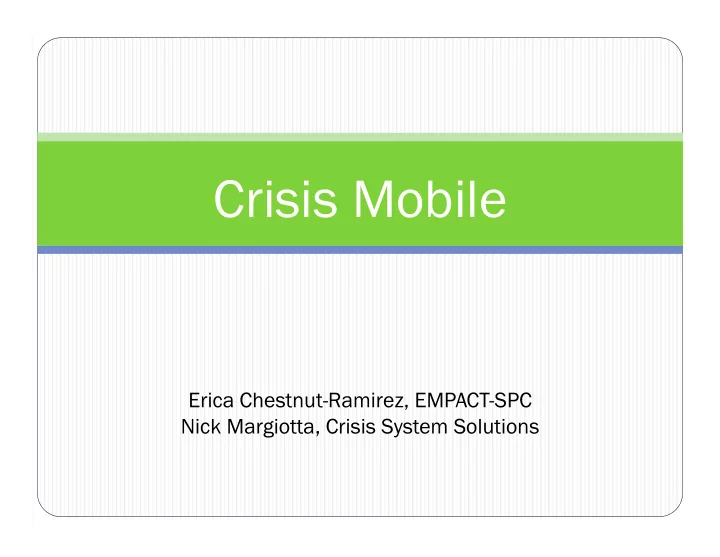

Crisis Mobile Erica Chestnut-Ramirez, EMPACT-SPC Nick Margiotta, Crisis System Solutions
How Mobile Crisis Fits Ho w Mobile Crisis Fits in the in the “Crisis No “Crisis Now” Model w” Model Prevention/Outpatient Telephonic Mobile Crisis Facility ED & Inpatient
Key “Precepts” y “Precepts” Ideal precepts of a mobile team – how to get there can differ Community Based-not hospital Stabilization vs. assessment 24/7 “Quick” Response 2 Person Responses ED/Jail Diversion are key to key program and fiscal goals Centrally Deployed “ATC” Model Majority of responses do not require a law-enforcement response
What Does a Mobile Crisis T What Does a Mobile Crisis Team “Do” am “Do” Provide Crisis Assessment, including a comprehensive Risk Assessment Crisis Intervention and de-escalation Safety plan with family/friends/supports involved; Arrange for HLOC if necessary (Detox, Crisis Facility) Transport When Necessary & Appropriate rather than using law-enforcement Set up follow up services; coordinate care for individual; Emergent petition/Non-emergent petition process
“Goals” “Goals” Community stabilization Individuals tend do better in their natural environment: builds confidence for future crisis Reduce Costs: Prevent over-use and misuse of emergency departments, psychiatric hospitalizations, and unnecessary law enforcement involvement Reduce trauma Facilitate referrals Removes barriers to seeking mental health crisis care Collaboration with key partners (in the community at key intercept points)
“Pr “Process” ocess” Respond via central dispatch, that does initial safety triage and coordination Can respond without L.E. to DTS, STO, etc. based on certain parameters Two-Person Responses…several variations i.e. Masters Level Clinician and Bachelors/BHT staff Two BHT Staff Peer Staff Partnered with other BH Staff On-Scene Assessment & Risk Considerations Typically MT requests a L.E. Response less than 5% of all responses If police already on-scene, focus is on releasing L.E. from scene as soon as possible . Level-of Care Determination & Transport Coordination and Referrals
Wh Why Collaboration is y Collaboration is Im Impor portant ant Law Enforcement is often first to encounter individuals with mental health issues. Can be Nexus to BH System & Treatment Does behavioral health really want individuals with mental health/substance abuse issues in the criminal justice system? Help Achieve BH System Goals Reduce Suicide Improved Client Outcomes Efficiency Reconnections & Recovery Opportunities Early Intercepts are key to healthy communities, reducing suicide, reducing use jail, ER, crime, etc.
La Law-Enf Enforcement “Considerations” ement “Considerations” Accessible and expedient hand offs to mobile crisis Quick and Certain Response Times “We got this” attitude Get Officers of-scene as soon as possible Behavioral health only calling PD when safety concern exist Builds trust between law enforcement and behavioral health Reduces belief about “dumping” Individuals in Crisis may be escalated by PD presence; mobile team looks like 2 people coming to visit in an unmarked mini van Law-Enforcement Requested Mobile Teams I.e. 3,000 Times a Year. Of the 18,000 MT Responses, less than 1,800 required any Police Response). Vast majority Stabilized in their Community, only about 15% Transported to Psychiatric/Substance Community Based Receiving Center by Mobile Team. Less than 3% Transported to Med/Surge E.D.
No. of PD Calls by Purpose Suicidal 121 Substance Abuse 8 Social 1 Self Harm Behavior 8 PTSD 1 Psychotic Symptoms 60 Partner-Relational 3 Parent-Child Relational 5 Medication 1 Medical 1 Legal 2 Housing Problems 9 Homicidal 9 Faxed Transport Request 1 Elder Issues 5 Economic Problems-Chronic 1 Depression 8 Coordination of Care-General 15 Coordination of Care-Follow up 2 Bereavement/Grief 4 Anxiety/Panic Attack 9 Aggressive/Assaultive Behavior 23 0 1 2 3 4 5 6 7 8 10 9 11 12 13 14 15 16 17 18 19 20 21 22 23 24 25 26 27 28 29 30 31 32 33 34 35 36 37 38 39 40 41 42 43 44 45 46 47 48 49 50 51 52 53 54 55 56 57 58 59 60 61 62 63 64 65 66 67 68 69 70 71 72 73 74 75 76 77 78 79 80 81 82 83 84 85 86 87 88 89 90 91 92 93 94 95 96 97 98 99 10 10 10 10 10 10 10 10 10 10 11 11 11 11 11 11 11 11 11 11 12 12 12 12 12 12 12 12 12 12 13 0 1 2 3 4 5 6 7 8 9 0 1 2 3 4 5 6 7 8 9 0 1 2 3 4 5 6 7 8 9 0 DRAFT
Examples 20,000 Crisis Calls a Month Less than 10% result in Crisis Mobile Dispatch Prevention/Outpatient Less than 1% result in a Police Response Requested 1,600 Mobile Team Responses a Month Less than 10% of Mobile Team Responses required a Police Telephonic Response Roughly 75% Of all Mobile Team Responses Stabilize individuals in their “Community” Of those that needed a HLOC, less than 3% transported to Mobile Med/Surge E.D. (i.e. minimal use of Ambo) Crisis Observation Admissions Crisis Approximately 70 ‐ 80% Stabilized and Discharged to Facility Community Involuntary Admissions ED & About 70% do not “complete” the involuntary process (i.e. Inpatient community stabilized, convert to voluntary, other levels of care, etc.)
Im Implementation & “Lessons Learned” plementation & “Lessons Learned” Staffing : Outpatient “perspective” Shift-Work/Work Force Funder Expectations Perceptions: o Has “schizophrenia”, don’t go alone, keep cops on, etc o Nights are scary Core measures…response time, time to release, community stabilization, etc. Roles of Peers
Im Implementation & “Lessons Learned” plementation & “Lessons Learned” Rural Considerations Different culture & Language barriers L.E. More likely to use Crisis System when easy to navigate and faith that service will be fast and reliable MT responds quickly Not a lot of “U.M.” or Triage Get officers off-scene early as possible
Questions????? Questions?????
Recommend
More recommend